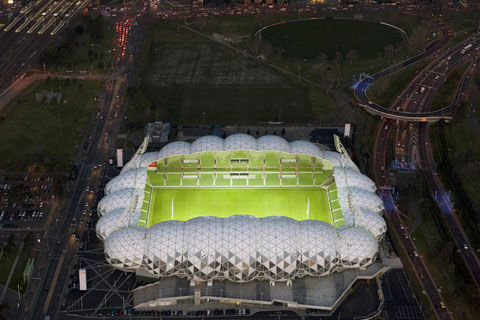PROJECT NAME: National Throws Centre of Excellence
PROJECT DESCRIPTION:
Fabritecture was contracted for the design and construction of a Serge Ferrari TX30 throws run up canopy for the State Athletics Facility at the Queensland Sports and Athletics Centre (QSAC) in Nathan, Queensland. The tensile building was built to house discus and hammer throwing. The result is a stunning and functional canopy that enhances the sports complex and provides a world-class facility for athletes to train and compete in.
DESIGN / FABRICATION / INSTALLATION BRIEF
The project brief from the client sought a solution to create a safe and secure training environment for athletes, specifically tailored to endure the region’s harsh weather conditions. The team addressed these needs by designing a throws run-up canopy with a conical shape and distinctive spiral rafters.
This design provides critical shade, mitigating heat stress and preventing sunburn, which allows athletes to train more effectively and for longer periods without concerns about dehydration or excessive sun exposure. Additionally, the conical form and twisting rafters not only serve a functional purpose but also enhance the overall aesthetics of the facility.
Despite the complexity of fabricating the spiral rafters, which presented significant challenges, the final product successfully combines durability with visual appeal. The resulting structure not only meets all functional and safety requirements but also elevates the facility’s visual impact, reflecting a thoughtful balance between practicality and design excellence.
STRUCTURAL SYSTEMS
The National Throws Centre of Excellence canopy features a unique conical spiral structure, blending aesthetic appeal with functional design. This innovative system uses a spiralling steel framework that supports the canopy and is precisely aligned with PVC cladding.
The conical geometry required meticulous structural analysis to handle wind and rain loads, ensuring stability and effective drainage. Ground conditions were assessed to design an appropriate foundation supporting the spiral form. The final solution emerged from extensive 3D modelling, structural analysis, and material coordination, culminating in a visually striking and structurally sound canopy that seamlessly integrates design and engineering excellence.
MATERIALS
The National Throws Centre of Excellence canopy project employs various carefully selected materials to achieve functionality and aesthetic appeal. The canopy utilises Ferrari TX30 fabric, known for its lightweight and durable properties, which reduces structural support requirements while offering exceptional UV resistance and design flexibility. This high-performance coated polyester fabric ensures longevity and resilience against environmental factors.
For the structural framework, galvanised steel is used due to its strength, corrosion resistance, and durability, making it ideal for supporting the canopy. Colorbond flashings are chosen for their weather resistance and aesthetic versatility, integrating seamlessly with the design while providing protection against the elements.
Additionally, perforated aluminium screens are employed for the soffit to allow for ventilation and maintain a sleek, lightweight profile while resisting corrosion. Together, these materials contribute to a high-quality, enduring structure that meets the project’s functional and visual demands.
FABRICATION
The National Throws Centre of Excellence canopy utilised advanced fabrication techniques and equipment to achieve precise construction. Locally manufactured steel met stringent carbon agreements, reflecting a commitment to sustainability.
COLLABORATION, CONSTRUCTION AND MAINTENANCE
The National Throws Centre of Excellence canopy project involved a coordinated effort among architects, engineers, and fabricators, facilitated by regular meetings and 3D modelling software to ensure design precision and alignment. Construction was carried out in phases, starting with site preparation and foundation work, followed by the erection of the prefabricated steel framework, and the installation of Ferrari TX30 fabric and aluminium screens.
The planned maintenance program includes routine inspections to check for structural integrity, periodic cleaning of the fabric using mild detergents, and regular checks for wear or corrosion on the steel framework. This approach ensures the canopy remains functional and aesthetically pleasing over time.
COSTS
The National Throws Centre of Excellence canopy project was valued at approximately AUD$279,000.
COLOUR IMAGES – Captions and Credits
COLOUR IMAGES – Captions and Credits
5936_01 Exterior shot of National Throws Centre of Excellence Canopy (Angus Martin Photography)
5936_02 Exterior shot of National Throws Centre of Excellence Canopy (Angus Martin Photography)
5936_03 Exterior shot of National Throws Centre of Excellence Canopy (Angus Martin Photography)
5936_04 Interior shot of National Throws Centre of Excellence Canopy (Angus Martin Photography)
5936_05 Interior shot of National Throws Centre of Excellence Canopy (Angus Martin Photography)
5936_06 Exterior shot of National Throws Centre of Excellence Canopy (Angus Martin Photography)
5936_07 Exterior shot of National Throws Centre of Excellence Canopy (Angus Martin Photography)
5936_08 Exterior shot of National Throws Centre of Excellence Canopy (Angus Martin Photography)
5936_09 Exterior shot of National Throws Centre of Excellence Canopy (Angus Martin Photography)
5936_10 Exterior shot of National Throws Centre of Excellence Canopy
5936_11 Exterior shot of National Throws Centre of Excellence Canopy
5936_12 Interior shot of National Throws Centre of Excellence Canopy
PKNote: DPID 421






